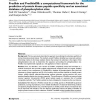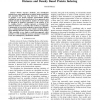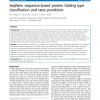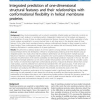69 search results - page 6 / 14 » Prediction of the Number of Residue Contacts in Proteins |
BMCBI
2008
13 years 7 months ago
2008
Background: We have previously described an approach to predicting the substrate specificity of serine-threonine protein kinases. The method, named Predikin, identifies key conser...
CIBCB
2009
IEEE
13 years 8 months ago
2009
IEEE
Protein structure similarity and classification methods have many applications in protein function prediction and associated fields (e.g. drug discovery). In this paper, we propose...
BMCBI
2010
13 years 7 months ago
2010
Background: Protein folding rate is an important property of a protein. Predicting protein folding rate is useful for understanding protein folding process and guiding protein des...
BMCBI
2010
13 years 7 months ago
2010
Background: Many structural properties such as solvent accessibility, dihedral angles and helix-helix contacts can be assigned to each residue in a membrane protein. Independent s...
BMCBI
2008
13 years 7 months ago
2008
Background: Designing small-molecule kinase inhibitors with desirable selectivity profiles is a major challenge in drug discovery. A high-throughput screen for inhibitors of a giv...




